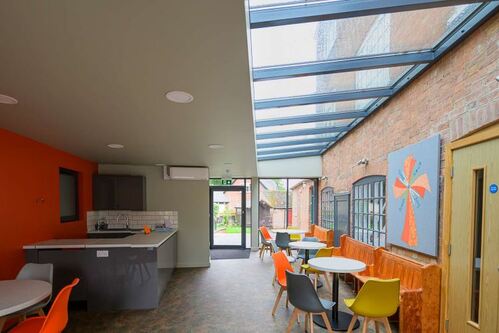A Brief History of Quorn Baptist Church Building

The original meeting house was the old granite-built house opposite the present chapel, which was licensed for meetings in 1760. This house was the home of Robert Parkinson who was really the prime mover in the commencement of the church in Quorn. By 1766, preaching was regularly introduced, the congregation grew and, in 1770, a neat, plain meeting house was built at a cost of £270.
In 1780, John Gamble, a name which has been prominent in the church since its inception, started the Sunday School. The same year, 1780, Adam Taylor’s history speaks of a wonderful revival in Quorn with a hundred believers professing their faith in the Lord Jesus Christ and offering themselves for baptism. The new meeting house was enlarged in 1780 at a cost of £160 but by 1790 it was again found to be too small to seat the members so the walls and roof were raised and galleries placed on three sides, all at a further cost of £200.
The three storied middle building housing the present vestry was erected in 1818. Further alterations took place in 1846 and 1861, all to give more seating accommodation. In 1884, some old cottages were purchased, demolished and the present Sunday Schoolroom built in 1897 at a cost of £540.
A major alteration took place in 1930 when the chapel was re-seated, electric lighting installed, the pulpit and organ moved, some windows re-sited and complete redecoration undertaken throughout.
During the 1970’s, the balcony was re-structured and re-seated, an additional suite of ladies toilets was provided in the main Sunday School hall and the men’s toilet block was re-built. The rear graveyard was levelled and the headstones removed to the perimeter walls and a vestibule was added to the front of the chapel.
In 2011 the organ and pews were removed from the chapel in favour of flexible seating and, in the following year, improvements were completed with the installation of modern lighting and heating. Picture of the inside of the chapel after the improvements of 2011/2012:
In 1780, John Gamble, a name which has been prominent in the church since its inception, started the Sunday School. The same year, 1780, Adam Taylor’s history speaks of a wonderful revival in Quorn with a hundred believers professing their faith in the Lord Jesus Christ and offering themselves for baptism. The new meeting house was enlarged in 1780 at a cost of £160 but by 1790 it was again found to be too small to seat the members so the walls and roof were raised and galleries placed on three sides, all at a further cost of £200.
The three storied middle building housing the present vestry was erected in 1818. Further alterations took place in 1846 and 1861, all to give more seating accommodation. In 1884, some old cottages were purchased, demolished and the present Sunday Schoolroom built in 1897 at a cost of £540.
A major alteration took place in 1930 when the chapel was re-seated, electric lighting installed, the pulpit and organ moved, some windows re-sited and complete redecoration undertaken throughout.
During the 1970’s, the balcony was re-structured and re-seated, an additional suite of ladies toilets was provided in the main Sunday School hall and the men’s toilet block was re-built. The rear graveyard was levelled and the headstones removed to the perimeter walls and a vestibule was added to the front of the chapel.
In 2011 the organ and pews were removed from the chapel in favour of flexible seating and, in the following year, improvements were completed with the installation of modern lighting and heating. Picture of the inside of the chapel after the improvements of 2011/2012:

In 2024-2025 a new annexe was built as an extension at the back of the church including a new minister's office, toilets, meeting rooms and a Welcome Street, including a kitchen area. For full details about the building of the new annexe, including photos and videos of the build as it progressed, please click here. Below is a photo of the new Welcome Street:

In short, the building, although Grade II listed and of significant historical interest, has been adapted over the years to meet the needs of the congregation and to fulfil the mission of service to the community of which it is a part.
A more comprehensive history, including a list of ministers, can be found in the Quorn Village online museum.
A more comprehensive history, including a list of ministers, can be found in the Quorn Village online museum.
